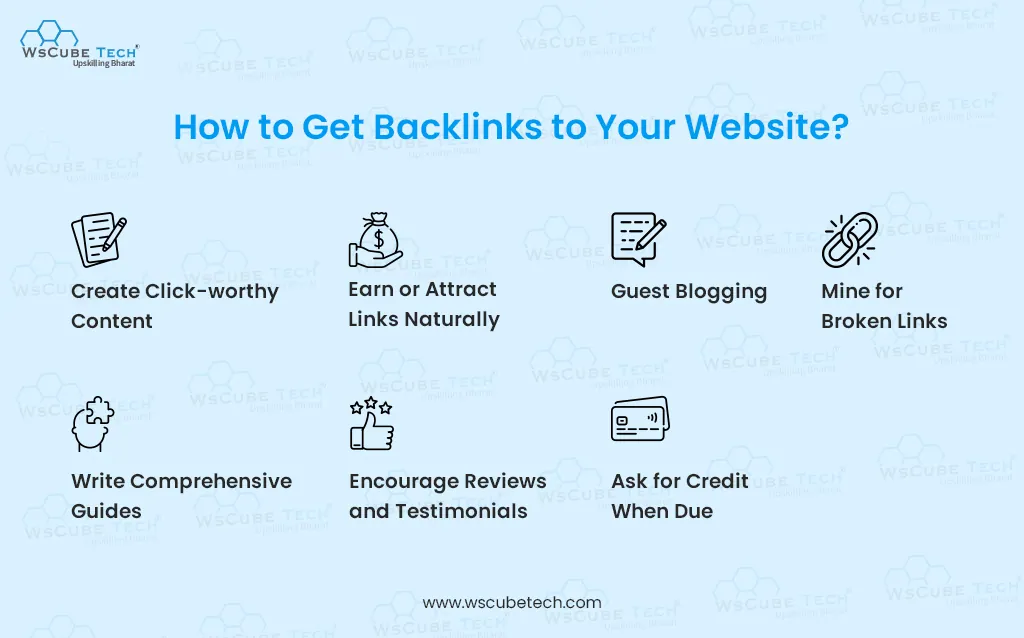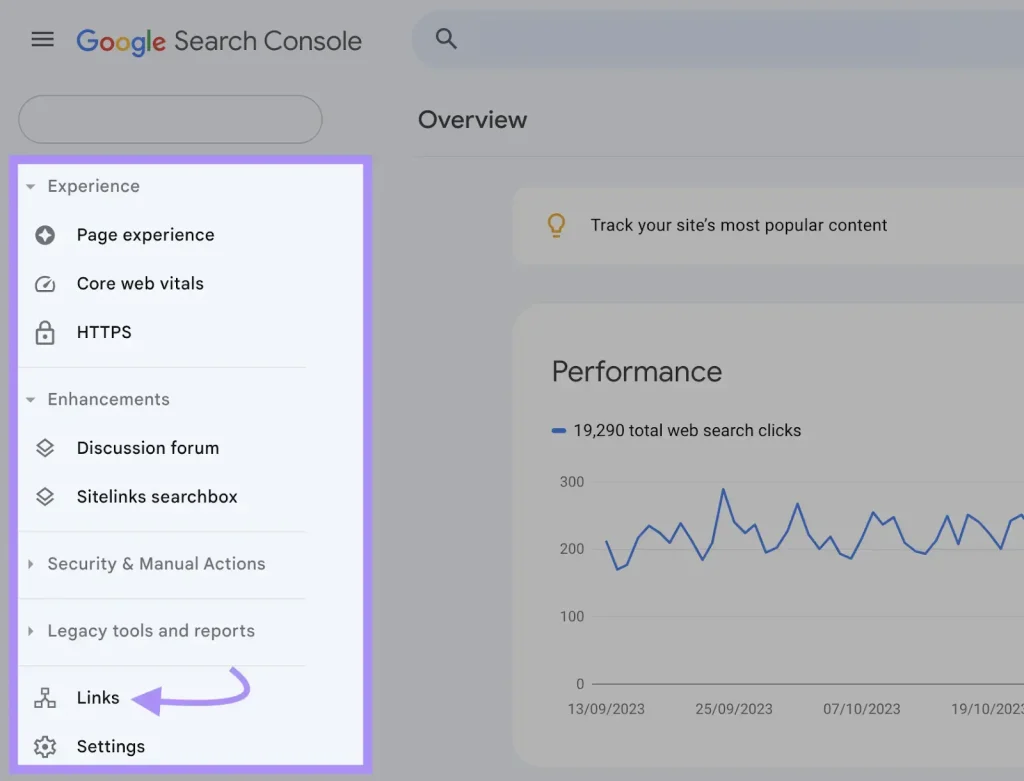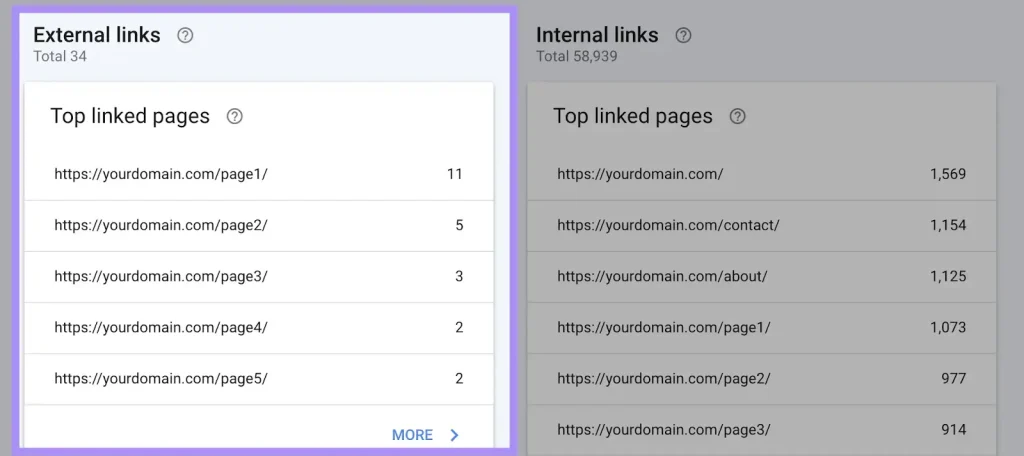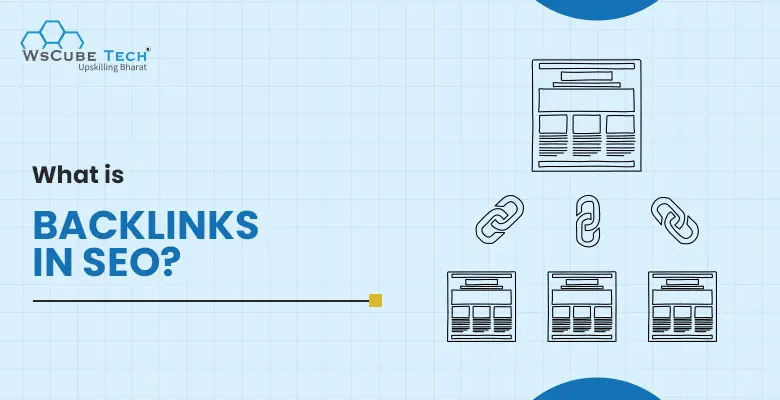Backlinks are inbound links that indicate traffic coming from other websites to yours. These links show that your website is popular and trusted by established businesses. Therefore, quality backlinks from reputed and high-authority websites have the potential to improve your rankings on search engines.
There are various techniques for creating and acquiring backlinks. In this blog, we will dive deeper into why backlinks are important, how to build backlinks, and more.

What Are Backlinks in SEO?
Backlinks are links that your website acquires or earn from other sites. They are like a vote of confidence that tells search engines they trust you and your content is credible, useful, and worth reading. The more links or votes your website earns, the higher it will reach on Google rankings.
The concept of backlinks is not new. It is an old and crucial part of the search engine algorithm. Although Google has made several changes in its algorithm over the years, backlinks continue to be a key ranking factor. In fact, they are among the top three essential factors for higher in search engine result pages.
Links drive organic and referral traffic to your site, increasing brand awareness and supporting your SEO efforts. Websites can naturally acquire backlinks, but marketers and website owners must work hard to generate and maintain them. Check out more about the value of the backlink through our SEO course!
Not all backlinks are created equal. You need to earn high-quality backlinks from reputable websites to rank higher on search engines. One quality backlink can outperform around 100 low-quality links.
There are two types of backlinks– total backlinks and total referral domains. The former refers to the total number of links your site gets from other domains, whereas the latter refers to the number of individual websites that share those links.
Upskill Yourself With Live Training (Book Free Class)
What are the Types of Backlinks?
There are two main types of backlinks: do-follow and no-follow.
1. Do-follow Backlink
Do-follow links are the most important type of link to get for SEO. They notify search engines that the information on the linked web page is noteworthy.
A do-follow link in a blog indicates that the website wants Google to note that the content on the other end adds knowledge to the blog. As such, they are often used as reference links in informative web content. From a user experience perspective, users can follow the link to learn more about the topic.
As valuable endorsements, do-follow links contribute to your site’s authority and credibility
for search engines, increasing your SEO performance. A well-executed backlink strategy for SaaS and e-commerce businesses helps your website get search engine rankings and attract more organic traffic, making it a necessary element for online success.
2. No-follow Backlink
No-follow backlinks are less critical than do-follow backlinks. SEOs use no-follow links to inform search engines to ignore the content or link on the other end as it is not considered relevant.
Even though no-follow links aren’t valuable in SEO and won’t shoot your content to top rankings on Google, yet they have a place in backlinking strategies. It’s essential to have a balance of no-follow and do-follow.
Why Are Backlinks Important?
As we said, backlinks are not a new concept in the world of digital marketing. It has been there since the introduction of Google’s original algorithm, PageRank. Although there have been many updates and changes in the algorithm, backlinks are still important to build website credibility and are considered a vital ranking signal.
The World Wide Web is filled with web pages and websites connected via links. These links form a web, telling spiders crawling the internet that more pages can be found by following the backlinks on the page.
Google views backlinks are recommendations from top-rated and reputable websites. It means that other leading websites and businesses vouch for your brand or content. Whenever a reputed website links to your web page, it tells search engines that its content is worth reading and linking to. This earns you additional points and positively influences your search engine ranking and online visibility.
So, the more backlinks your page has, the more trustworthy and authoritative it is considered, especially when these links come from trusted sources.
Suppose you launch a new business or website. There are no links to it or any mention on the web. Also, you have not submitted it to Google. So, how would Google find it? It is when a well-known site links to your website. Search engines crawl through the backlinks to discover your site and index your content. Without any link, crawlers won’t even know your content exists on the internet. Hence making backlinks crucial.
Two primary reasons that backlinks are important are as follows:
- Links boost search engine rankings. The more backlinks a page has, the more chances are for it to rank higher for relevant search queries.
- Backlinks make content discoverable. Search engines can easily find your content by following backlinks coming from popular pages.
Also Read: What Are Meta Tags in SEO? All Meta Tags Explained
How Do Backlinks Work?
Backlinks alone are not enough to support your SEO efforts. You also need quality content and an effective content marketing strategy to drive better results. Optimized content with high-quality backlinks plays a major role in search engine algorithms and your business’ accelerated growth.
Backlinks are no less than conversations between two websites, where the site with the link tells that it trusts the linked website and considers the content useful.
For example, a famous blogger mentions a link to the XYZ website in his post. He posts this content on his site, adding a hyperlink to it. Users reading the content will be compelled to visit the XYZ site to find more information related to the topic.
How to Get Backlinks to Your Website?

Getting backlinks from reputable websites to your site is essential for an effective SEO campaign. It helps drive organic traffic and build brand awareness.
There are several ways to get high-quality to your site, each aiming to increase referral traffic, search engine rankings, and visibility.
Let’s explore the seven most effective link-building strategies that you can try:
1. Create Click-worthy Content
Creating quality and optimized content is among the best methods to earn backlinks. When you have informative and useful content that provides valuable insights into a particular topic, people will add your link to their site without hesitation.
So, focus on developing content that is authentic and detailed to attract more links and clicks. This will increase the likelihood of others referencing your content. Also, your content should be well-researched and answer a specific query of the target audience. Content should also be search engine-friendly and optimized.
As more people will click on your link and find your content useful, it will also win the trust of search engines and your page will rank higher on SERPs. It can be any form of content, including articles, infographics, guides, tools, or videos.
Here are a few tips to create optimized content:
- Cover the topic in detail
- Conduct in-depth keyword research
- Include relevant keywords in your page title, headers, and content
- Avoid keyword stuffing
- Use images and short sentences to make it readable
- Link to relevant web pages
2. Earn or Attract Links Naturally
When people discover your content or page via their search on Google, word of mouth, or social media, and link to it, it’s known as earned links. You don’t make any effort to get these links.
For example, a reputed website finds your article on the ‘top 10 SEO tools‘ useful and includes its link as a recommended resource for its users. So, you have just created top-notch content, due to which it earns links on popular websites.
Thus, you attract natural links by creating excellent and link-worthy asset that others find useful and worth recommending. You can increase your chances of earning quality backlinks by developing relevant and valuable content. Anyone impressed by it would not mind including its link. However, promote your content so that it can reach to more people and earn more links.
Also Read: What is Local SEO? Benefits, Ranking Factors, Process
3. Guest Blogging
Another white-hat SEO method to build backlinks is guest blogging. It is a practice of writing informative and helpful articles for other websites in exchange for links. Guest posts allow you to build an impressive backlink profile organically through studies, articles, and other resources. Also, it’s your chance to get links from reputed and trusted sites.
Moreover, when you write for top websites, you can gain exposure and mark your presence among their established audience who might be interested in your product or service. Links added to guest articles or posts support your SEO efforts and drive organic traffic from the website with your link.
Find websites that accept guest posts from contributors and bloggers. Make sure these sites are relevant to your business, product, or service. Also, these sites must have higher domain authority so you can have more traffic and Google trusts you more. Higher domain authority means higher chances of ranking at the top in the SERPs. To learn more about ranking your website at the top in SERPs, enroll in an online SEO course now!
You can explore guest posting sites on Google using “target keyword + write for us”. Click ‘Write For Us’ and go through terms and conditions carefully. Find contact details and write an email to introduce your business.
Mention the idea of the article you want to submit for guest posts. Repeat the process to earn more backlinks and mark your place as an industry leader.
Guest blogging includes the following steps:
- Find relevant websites
- Connect and pitch
- Write and submit the guest post
- Promote your content and engage
Interview Questions for You to Prepare for Jobs
| Digital Marketing Interview Questions | SEO Interview Questions |
| Email Marketing Interview Questions | Content Writing Interview Questions |
4. Mine for Broken Links
Suppose a user is looking for information urgently and clicks a broken link to your site. What do you think will happen? It will lead to frustration, disappointment, and, ultimately, the loss of a potential customer. Broken links hamper user experience and can harm your search engine rankings.
According to a recent update in Google’s algorithm, the focus is more on overall page experience. So, you need to find broken or dead links on third-party websites, reach out to those websites, and ask them to replace them with your relevant links.
Although the broken link-building technique demands time and effort, it can help you build a credible backlink profile. Also, you can help website owners fix links that no longer exist and add value to their content by providing suitable substitute. If you use the opportunity wisely, websites will easily accept your offer and add your link to their content.
However, the effectiveness of broken link-building significantly depends on the relevance of your content and your convincing power. Here are the key steps to follow to mine broken links:
- Find relevant websites
- Identify broken links
- Determine suitable link-building opportunities
- Connect with website owners
- Suggest replacement links
- Follow up

5. Write Comprehensive Guides
Ultimate guides are long-form articles explaining a specific topic in detail, covering all the key concepts and comprising relevant keywords. As the name suggests, the ultimate guide provides complete knowledge of the given subject, enabling readers to learn more.
Pick trending topics and write a step-by-step guide so readers can gain a fair understanding. Your content must stay relevant for a long period and update the information whenever required to promote it and draw the attention of learners.
Include the target keywords throughout the content and keep the structure organized and simple. It will allow users to follow the guide and learn without hassle. Reach out to websites in your niche and tell them how your comprehensive guide will be helpful for their readers.
A well-written and researched guide can help your business build a strong backlink profile.
6. Encourage Reviews and Testimonials
Testimonials or reviews are like endorsements from happy clients who recommend your product or service to others. This is one of the best ways to acquire organic backlinks while building credibility and brand awareness.
Whenever customers submit feedback on any social media platform or website, they can add a link to your site so people can know more about your brand and make an informed buying decision.
To get more reviews, connect with your customers and encourage them to share their experience on popular platforms like Yelp. You can reach out to them via email or message and request them to write feedback and include your site’s link.
Also Read: What Are LSI Keywords in SEO? Examples, Benefits, Use
7. Ask for Credit When Due
Just the mention of your business or website is not enough. For example, review about your product or mention of your content without linking to your site. You need proper credit to establish yourself as an expert in the industry and attract more clicks.
So, check all the brand mentions and ensure they link to your website. Ask customers or websites referencing your business to provide a backlink. Also, if a blog or website is referencing your original research, it must provide a link.
You can find your website or business mentions using Google Alerts or similar tools. They will automatically notify you whenever somebody mentions your business on the internet.
How to Check Backlinks?
Checking backlinks helps you enhance your link-building strategy, track performance, and analyze competitors. But how do you check your site’s backlinks? Well, there are plenty of tools to check all the links of any given URL. Below, we will learn how to check backlinks using Google Search Console, one of the easiest ways to get insights into your backlink profile:
Checking Backlinks to Your Website
Sign in to Google Search Console and click ‘Links’ on the sidebar. Under the ‘External Links’ column, you will see a list of all the links, showing you the total number of backlinks to your site and an overview of your backlink profile.


However, Google Search Console has its limitations, so you can see limited data. Also, there will be no useful SEO metrics to analyze your backlinks.
Here’s what you can check:
Top Linked Pages- These are the pages on your website with the most links.
Top Linking Sites- These are the sites that have given you the most links.
Top Linking Text- These are the most used anchor texts for backlinks.
Click on ‘More’ for a detailed report and export it as a CSV file by clicking the “Export External Links” button at the top-right of the screen.
These reports will show more information, including exactly which sites are linked to which pages on your site.
To check backlinks for other sites, you can use third-party tools, such as SEMrush, Ahrefs, Moz, etc. You simply need to enter the URL and you will have detailed report in no time.

Are All Backlinks Valuable for SEO?
No, not every backlink is valuable and beneficial for SEO. For example, no-follow links don’t pass any link equity to the linked site. Hence, they hardly add any value.
No-follow links have the following attributes in their code:
rel=“nofollow”- It tells Google that the linking site doesn’t endorse the target website.
rel=“sponsored”- It indicates that the target site has paid for the link.
rel=“ugc”- It shows that the link is included in the user-generated content.
Apart from no-follow links, Google also ignores low-quality or irrelevant links or links on spammy sites. It also doesn’t count backlinks acquired through unethical or spam policies. Other bad practices include link exchanges, adding keywords to anchor text in a spammy way, exchanging money or goods for links, and using automated tools to create links. These are also known as toxic backlinks and can even lead to penalties that can harm your SEO.
Best Backlinks in SEO
The following are the best and most valuable links:
- Placed naturally within relevant content
- Do-follow links
- Used with relevant anchor text
- Links from reputed websites
- Linked to functional and quality pages
Try to acquire backlinks from different websites and target different anchor texts and web pages; otherwise, your backlink profile may look spammy and unnatural.
FAQs on What are Backlinks?
A backlink is when a website links to another with anchor text. Any blog that links to another website or source is an example of a backlink.
Backlinks offer better site SEO because they increase your site’s authority and rank you higher for target keywords in SERPs. The quality of the website’s links back to you matters more than the number of backlinks you have.
Creating high-quality content is the best way to attract backlinks from high-authority sites. When you produce original and insightful content in blogs, infographics, and videos, you’re more likely to be cited by these reputable websites. Remember, you can also link to these sources in your content to increase visibility.
Increase your website’s authority and credibility, as they signal that other websites trust and recommend your content.
Attract organic traffic to your website by improving your ranking for relevant keywords and topics.
Expand your audience and reach by exposing your website to new and diverse groups of users who may be interested in your products. With other SEO techniques, businesses can capitalize on new customer segments to proliferate.
Conclusion
Backlinks play a crucial role in search engine rankings. However, building quality links demands ample time and effort. Also, not every link is made equal. So, you must assess relevancy, credibility, and other factors before you create a link.
Start building an excellent backlink profile now and seize all possible opportunities to create brand awareness and rank higher on SERPs.
Read more blogs:



